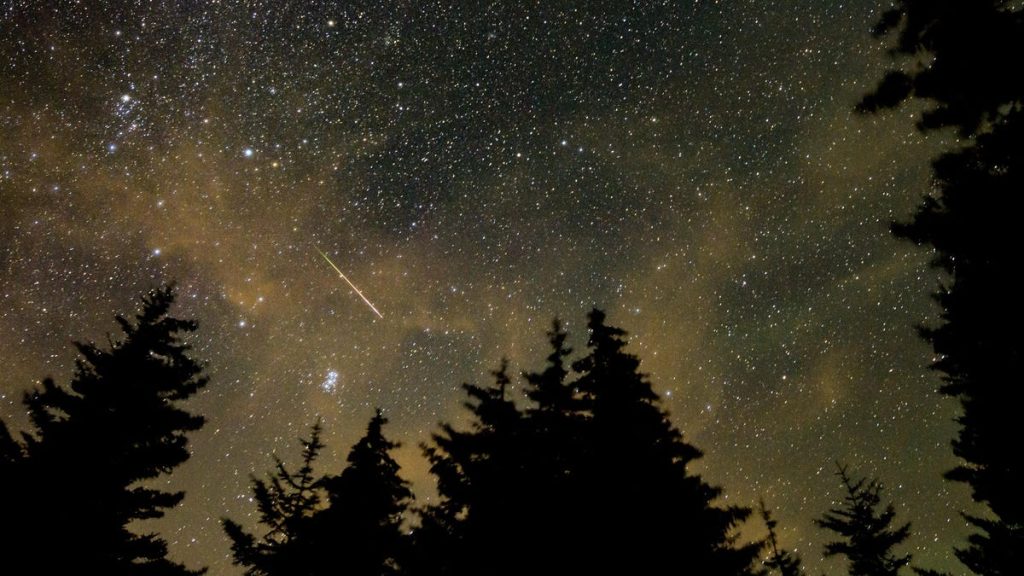I, For One, Welcome Our New Alien Overlords

In this 30 second exposure, a meteor streaks across the sky during the annual Perseid meteor shower, Wednesday, Aug. 11, 2021, in Spruce Knob, West Virginia.Photo: NASA/Bill Ingalls
Two teams of astronomers are getting ready to send a direct message out into space to signal to other intelligent life. The message they’re sending boils down to: Hey! We’re here! We know basic math! It could be decades, or even centuries, before we hear a reply, if there’s anything out there at all. That could be a very good thing.
Ars Technica has an interesting story about messaging extraterrestrial intelligence, or METI, the more direct communication version of SETI, which passively listens for broadcasts from beyond the stars. So far, SETI has found zilch.
While you may have heard we’ve been sending broadcasts out to the stars for 100 years now, radio and television waves actually defuse below the background radiation of the universe fairly quickly. The three tiny spacecraft we’ve sent beyond our solar system have an infinitesimal chance of ever being found in the vastness of space. Instead of hoping to be found or listening for other civilizations, two teams working on separate projects will use electromagnetic radiation to communicate directly with spots in our galaxy which look promising for intelligent life:
One of these new messages will be sent from the world’s largest radio telescope, in China, sometime in 2023. The telescope, with a 1,640-foot (500-meter) diameter, will beam a series of radio pulses over a broad swath of sky. These on-off pulses are like the 1s and 0s of digital information.
The message is called “The Beacon in the Galaxy” and includes prime numbers and mathematical operators, the biochemistry of life, human forms, the Earth’s location, and a time stamp. The team is sending the message toward a group of millions of stars near the center of the Milky Way galaxy, about 10,000 to 20,000 light-years from Earth. While this maximizes the pool of potential aliens, it means it will be tens of thousands of years before Earth may get a reply.
The other attempt is targeting only a single star, but with the potential for a much quicker reply. On October 4, 2022, a team from the Goonhilly Satellite Earth Station in England will beam a message toward the star TRAPPIST-1. This star has seven planets, three of which are Earth-like worlds in the so-called “Goldilocks zone”—meaning they could be home to liquid and potentially life, too. TRAPPIST-1 is just 39 light-years away, so it could take as few as 78 years for intelligent life to receive the message and Earth to get the reply.
Scientists are trying to solve what is called “The Great Silence.” For 70 years, we’ve searched for signs of fellow advanced civilizations among the stars. Despite hundreds of millions of habitable worlds in our galaxy alone we’ve found zero evidence of any life, much less intelligent life, outside of planet Earth. This is Fermi’s Paradox; there should be civilizations everywhere, so where is everyone?
There are quite a few possible explanations. Civilizations reach turning points where they either thrive or self-destruct, and none have survived; we are too far off the beaten path for space faring civilizations; we have been visited but didn’t notice; we aren’t using similar enough technologies to communicate; and space travel is simply impossible. But my favorite theory is the Dark Forest theory, which is a reference to a series of books called The Three Body Problem by Chinese sci-fi author Liu Cixin:
The universe is a dark forest. Every civilization is an armed hunter stalking through the trees like a ghost, gently pushing aside branches that block the path and trying to tread without sound. Even breathing is done with care. The hunter has to be careful, because everywhere in the forest are stealthy hunters like him. If he finds another life—another hunter, angel, or a demon, a delicate infant to tottering old man, a fairy or demigod—there’s only one thing he can do: open fire and eliminate them.
Maybe everyone out there is being quiet because something big and predatory is stalking through our own dark forest. Maybe shouting to the heavens is the exact opposite of what we should be doing. A few years before his death, Stephen Hawkings said on a CuriosityStream broadcast about attempts to contact aliens, according to Space.com:
“One day, we might receive a signal from a planet like this,” Hawking says in the documentary, referring to a potentially habitable alien world known as Gliese 832c. “But we should be wary of answering back. Meeting an advanced civilization could be like Native Americans encountering Columbus. That didn’t turn out so well.”
I, for one, welcome our new future alien overlords.





